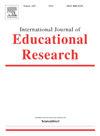多元世界中的东南亚跨区域研究合作:当前趋势与未来路径
IF 2.5
3区 教育学
Q1 EDUCATION & EDUCATIONAL RESEARCH
引用次数: 0
摘要
东南亚目前正经历着高等教育系统区域协调的势头,最近在2024年8月宣布的共同高等教育空间也表明了这一点。虽然仍需取得很大进展,但东盟为将10个国家聚集在一起而提出的有意义的倡议以及东南亚教育组织在与教育有关的协调方面的作用对上述努力非常重要。东南亚多元化的人口渴望创造一个与世界其他地区和国家紧密联系的包容和谐的空间。因此,研究东南亚高等教育的跨区域研究合作对于观察其与其他地区和国家联系的当前趋势和未来路径至关重要。本研究利用大规模文献计量数据,考察了东南亚与全球和区域相关系统的跨区域研究合作模式。调查的重点是主要趋势、基于研究领域的分析、合作倡议和引文识别。这些分析表明,该地区的研究人员在研究合作的几乎所有方面的数量都有所增加。基于区域的分析表明,与与欧盟的社会科学和人文科学以及与美国的医学科学相比,该地区与中国的合作主要集中在STEM领域,突出了合作方在特定领域的专业知识。研究结果还表明,以主要作者比例衡量,东南亚的科学家在跨区域合作中的地位是不平等的。此外,与现有的讨论一致,跨区域合作增加了被引影响,但该地区研究人员发表的整体合作论文的被引认可度仍有提高的空间。本文章由计算机程序翻译,如有差异,请以英文原文为准。
Southeast Asia’s cross-regional research collaborations in the multiplex world: Current trends and future paths
Southeast Asia is currently experiencing momentum towards the regional harmonisation of its higher education systems, as also indicated by the recent declaration of the common higher education space in August 2024. Although much progress is still needed, the meaningful initiatives of ASEAN to bring together the ten countries and the role of SEAMEO in education-related harmonisation are important for the aforementioned endeavour. The diverse populations of Southeast Asia aspire to create an inclusive and harmonious space that is well-connected with other regions and nations worldwide. Thus, investigating the cross-regional research collaborations of Southeast Asian higher education is crucial to observing current trends and future paths for its connectivity with other regions and nations. This study examines the patterns of Southeast Asia’s cross-regional research collaborations with globally and regionally relevant systems using large-scale bibliometric data. The investigation focuses on major trends, research-area-based analyses, collaboration initiatives, and citation recognition. The analyses indicate a numerical increase in almost all aspects of research collaborations by researchers based in the region. Area-based analyses indicate that the region’s collaborations with China focus on STEM areas, as compared to social science and humanities with the EU and medical sciences with the US, highlighting the collaborating side’s expertise in specific areas. Findings also indicate that Southeast Asia-based researchers are unequally positioned in cross-regional collaborations as measured by leading authorship proportions. Furthermore, consistent with existing discussions, cross-regional collaborations increase citation impact, but there is room to increase the citation recognition of overall collaborative papers published by researchers in the region.
求助全文
通过发布文献求助,成功后即可免费获取论文全文。
去求助
来源期刊

International Journal of Educational Research
EDUCATION & EDUCATIONAL RESEARCH-
CiteScore
6.20
自引率
3.10%
发文量
141
审稿时长
21 days
期刊介绍:
The International Journal of Educational Research publishes regular papers and special issues on specific topics of interest to international audiences of educational researchers. Examples of recent Special Issues published in the journal illustrate the breadth of topics that have be included in the journal: Students Perspectives on Learning Environments, Social, Motivational and Emotional Aspects of Learning Disabilities, Epistemological Beliefs and Domain, Analyzing Mathematics Classroom Cultures and Practices, and Music Education: A site for collaborative creativity.
 求助内容:
求助内容: 应助结果提醒方式:
应助结果提醒方式:


